Work Opportunity Tax Credit (WOTC): What it is, How to claim & where to file
In this article Work Opportunity Tax Credit explained: Learn what WOTC is, steps to claim, eligibility criteria, and where to file it for maximum benefit in call centers/BPOs
5 min read
The Work Opportunity Tax Credit (WOTC) is a significant incentive for businesses that encourages the hiring of individuals from specific target groups, which have consistently faced significant barriers to employment.
Utilizing the WOTC can not only enhance your workforce diversity but also provide substantial financial savings. Understanding what the WOTC is, how to claim it, and where to file is essential for maximizing its benefits.
The WOTC has a twofold purpose. It provides tax credits to employers who hire individuals from targeted groups, and it helps those individuals build employment skills and work towards financial stability.
According to the U.S. Department of Labor, these target groups include veterans, people who have been unemployed for a long time, and recipients of government assistance programs, among others.
As a call center or BPO operation, incorporating WOTC into your recruitment strategy can dramatically reduce hiring costs while fostering a more inclusive work environment. Data from the Center on Budget and Policy Priorities suggests that skilled, diverse teams can drive innovation and improve company performance.
In this blog post, we will take an in-depth look into what the Work Opportunity Tax Credit is, the steps to claim it, and where to file.
By integrating these insights, CXOs, HR managers, and operations managers in call centers and BPOs can better leverage WOTC to their advantage and secure significant financial and social gains for their organizations.
What is the Work Opportunity Tax Credit?
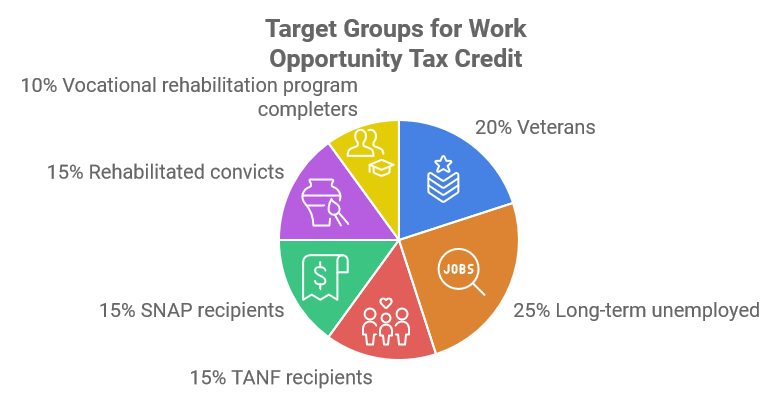
The Work Opportunity Tax Credit is a federal tax credit available to employers who hire individuals from specific groups that have historically faced obstacles in entering the workforce. The credit is intended to encourage workplace diversity and reduce the barriers to employment for these targeted groups.
These target groups include veterans, long-term unemployed individuals, recipients of Temporary Assistance for Needy Families (TANF) or Supplemental Nutrition Assistance Program (SNAP) benefits, rehabilitated convicts, and those who have completed a vocational rehabilitation program, among others.
The goal of the WOTC is to incentivize employers to provide opportunities to individuals who may otherwise face difficulties in securing employment, thus reducing their dependence on public assistance programs and fostering economic self-sufficiency.
Pro Tip
To maximize your potential tax credits, regularly review and update your hiring practices and employee onboarding processes to ensure you are identifying all eligible candidates for WOTC.
Eligibility criteria for employees for WOTC
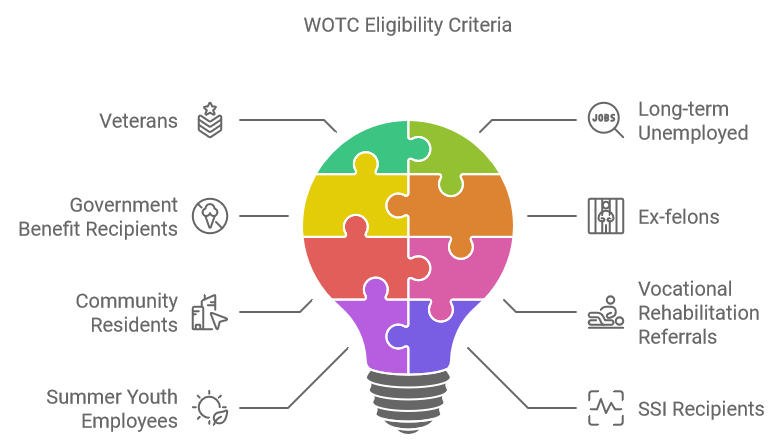
To qualify for the Work Opportunity Tax Credit, the employee being hired must belong to one of the target groups specified by the federal government. Here are the categories:
- Veterans who meet certain conditions
- Long-term unemployed individuals (27 consecutive weeks of unemployment)
- Recipients of TANF, SNAP, and other government benefits
- Ex-felons hired within a year after their conviction or release
- Designated community residents living in Empowerment Zones or Rural Renewal Counties
- Vocational rehabilitation referrals
- Summer youth employees living in Empowerment Zones
- Supplemental Security Income (SSI) recipients
- Long-term family assistance recipients
It’s critically important to verify the eligibility of each new hire. The U.S. Department of Labor provides detailed descriptions and requirements for each target group.
Pro Tip
Implement a standardized process for verifying WOTC eligibility at the time of hire. Utilize the IRS Form 8850 and the ETA Form 9061 for initial screening during the recruitment process to simplify the documentation and filing later.
Steps to claim the Work Opportunity Tax Credit
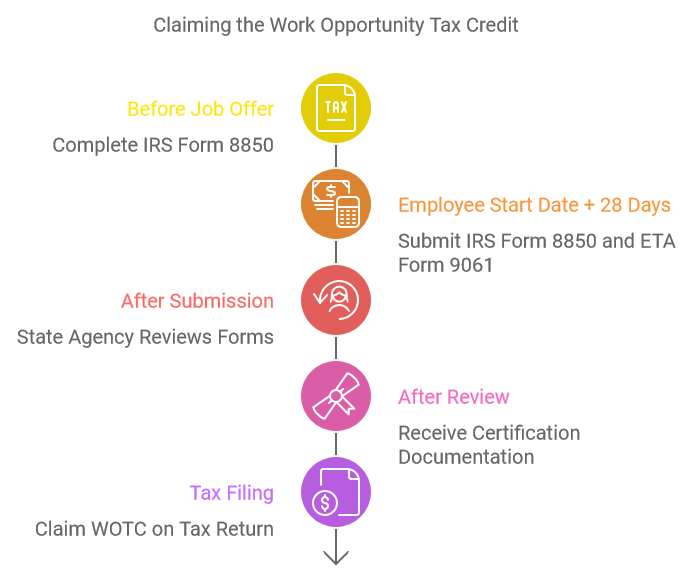
Claiming the WOTC involves several steps to ensure that you properly document and verify eligible hires. Here is a step-by-step process to guide you:
- Pre-screening and Certification: Complete the IRS Form 8850 (Pre-Screening Notice and Certification Request) on or before the day a job offer is made to an applicant.
- Submit Forms: Submit the completed IRS Form 8850 and the ETA Form 9061 (Individual Characteristics Form), either together or separately, to your state workforce agency within 28 days of the employee’s start date.
- State Agency Review: The state workforce agency will then review the forms to certify whether the new hire meets the criteria for a targeted group.
- Receive Certification: If the criteria are met, the state agency will provide certification documentation, verifying the employee’s eligibility for the WOTC.
- Claim the Credit: Use this certification to claim the WOTC on your business’s tax return. This involves filing the IRS Form 5884 (Work Opportunity Credit) along with your annual tax return.
Following these steps ensures that you secure the tax credits your business is entitled to, reducing your overall tax liability.
Pro Tip
Maintain detailed and organized records of all WOTC-related documentation. This will make it easier to provide proof of compliance in the event of an audit or review by the IRS.
Calculating the Work Opportunity Tax Credit
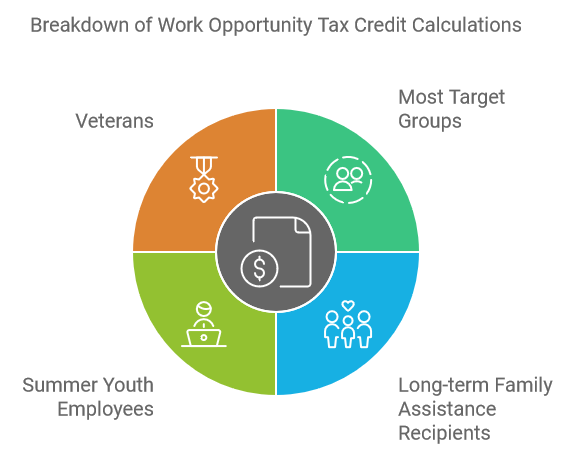
The amount of the Work Opportunity Tax Credit that an employer can claim varies based on the employee’s target group and the number of hours worked. Generally, the credit is calculated as a percentage of the qualified wages paid to the employee within the first year of employment.
Here is a general breakdown of how the credit is calculated:
- For most target groups: The credit is 40% of qualified first-year wages up to $6,000 for employees who work at least 400 hours. For those who work at least 120 but less than 400 hours, the credit is 25% of qualified wages up to the same amount.
- For long-term family assistance recipients: The credit is up to $9,000, calculated over a two-year period ($10,000 each year at 40% for the first year and 50% for the second year).
- For summer youth employees: The credit is 40% of the first $3,000 in wages paid.
- For veterans: Specifics vary widely based on the veteran’s qualifying status, reaching up to $24,000 depending on disability status and length of unemployment.
Understanding how to calculate the WOTC is critical for leveraging the full financial benefits provided by this federal program.
Pro Tip
Utilize payroll software with integrated WOTC calculation features to automate the process and minimize the risk of errors in your tax filings.
Where to file for the Work Opportunity Tax Credit
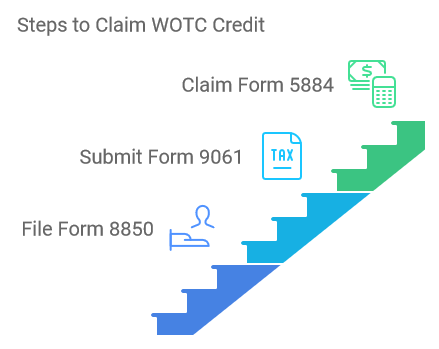
Once you have all necessary documentation and certification to show that a new hire is WOTC eligible, you must file for the credit. Here’s how you can do that:
- IRS Form 8850: This form is filed with your state workforce agency.
- ETA Form 9061: This is also submitted to the state workforce agency for certification alongside Form 8850.
- Claim Form 5884: After receiving certification from the state agency, claim the WOTC credit using IRS Form 5884 with your business’s annual federal income tax return.
The filing process can be cumbersome, but meticulous record-keeping and accurate submission of forms are essential to ensure your business receives the WOTC benefits it qualifies for.
Pro Tip
Consult with a tax professional or a specialized service to assist with WOTC paperwork and filing, ensuring that you don’t miss out on any potential credits due to submission errors or deadlines.
Maximizing Work Opportunity Tax Credit Benefits for Call Centers and BPOs
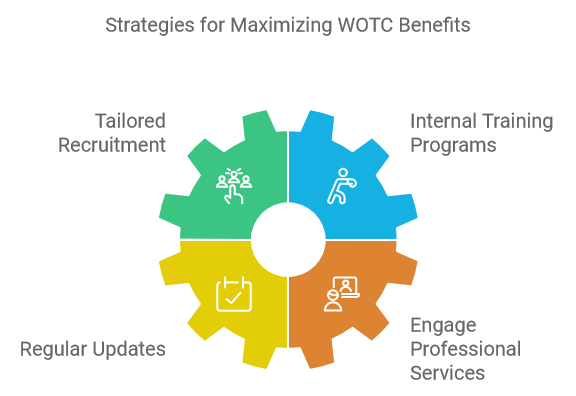
For call centers and BPOs, particularly those with 51-500 employees, WOTC can significantly offset recruitment costs. Here are tailored strategies to maximize WOTC benefits:
- Tailored Recruitment: Focus recruitment efforts on channels more likely to yield candidates from WOTC target groups. Collaborate with veterans’ organizations, rehabilitation centers, and job training programs.
- Internal Training Programs: Develop internal programs to support new employees from WOTC target groups, ensuring a smoother integration and retention, thus maximizing your credit claims over time.
- Regular Updates: Stay updated with any changes in WOTC legislation or target groups to ensure continued eligibility and compliance.
- Engage Professional Services: Consider hiring a third-party service to manage the WOTC process, from paperwork to filing, freeing up internal resources and ensuring all potential credits are captured.
By focusing on these strategies, call centers and BPOs can create a win-win situation by driving employment opportunities for marginalized groups while significantly reducing their own tax liabilities.
Pro Tip
Conduct quarterly reviews of your WOTC strategy and outcomes to identify areas for improvement and to ensure you are capturing all relevant tax credits.
Conclusion
The Work Opportunity Tax Credit is a valuable tool for businesses looking to foster a diverse workforce while mitigating recruitment costs. By understanding what the WOTC is, the qualifications necessary, the steps to claim, the calculations involved, and the filing procedures, businesses can fully leverage the financial and social benefits this federal program offers.
For organizations aiming to stay competitive and inclusive, the WOTC provides both a financial incentive and an opportunity to make a lasting positive impact. As such, incorporating WOTC into your hiring strategy is not just beneficial, but a strategic imperative in today’s business environment.
Pro Tip: Annually review the WOTC benefits reaped by your organization in the context of your overall financial strategy to gauge its impact and ensure alignment with long-term business goals.
By conscientiously integrating the WOTC into your human resources and operational processes, your call center or BPO can achieve substantial fiscal savings while contributing to broader societal goals.



